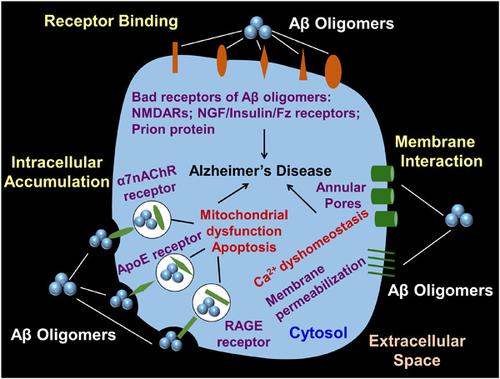当前位置:
X-MOL 学术
›
J. Cell. Biochem.
›
论文详情
Our official English website, www.x-mol.net, welcomes your
feedback! (Note: you will need to create a separate account there.)
Distinct types of amyloid-β oligomers displaying diverse neurotoxicity mechanisms in Alzheimer's disease
Journal of Cellular Biochemistry ( IF 3.0 ) Pub Date : 2021-09-07 , DOI: 10.1002/jcb.30141 Priyanka Madhu 1, 2 , Samrat Mukhopadhyay 1, 2, 3
Journal of Cellular Biochemistry ( IF 3.0 ) Pub Date : 2021-09-07 , DOI: 10.1002/jcb.30141 Priyanka Madhu 1, 2 , Samrat Mukhopadhyay 1, 2, 3
Affiliation

|
Soluble oligomers of amyloid-β (Aβ) are recognized as key pernicious species in Alzheimer's disease (AD) that cause synaptic dysfunction and memory impairments. Numerous studies have identified various types of Aβ oligomers having heterogeneous peptide length, size distribution, structure, appearance, and toxicity. Here, we review the characteristics of soluble Aβ oligomers based on their morphology, size, and structural reactivity toward the conformation-specific antibodies and then describe their formation, localization, and cellular effects in AD brains, in vivo and in vitro. We also summarize the mechanistic pathways by which these soluble Aβ oligomers cause proteasomal impairment, calcium dyshomeostasis, inhibition of long-term potentiation, apoptosis, mitochondrial damage, and cognitive decline. These cellular events include three distinct molecular mechanisms: (i) high-affinity binding with the receptors for Aβ oligomers such as N-methyl-
d-aspartate receptors, cellular prion protein, nerve growth factor, insulin receptors, and frizzled receptors; (ii) the interaction of Aβ oligomers with the lipid membranes; (iii) intraneuronal accumulation of Aβ by α7-nicotinic acetylcholine receptors, apolipoprotein E, and receptor for advanced glycation end products. These studies indicate that there is a pressing need to carefully examine the role of size, appearance, and the conformation of oligomers in identifying the specific mechanism of neurotoxicity that may uncover potential targets for designing AD therapeutics.
中文翻译:

不同类型的淀粉样蛋白-β寡聚体在阿尔茨海默病中表现出不同的神经毒性机制
淀粉样蛋白-β (Aβ) 的可溶性低聚物被认为是阿尔茨海默病 (AD) 中的关键有害物种,可导致突触功能障碍和记忆障碍。许多研究已经确定了具有异质肽长度、大小分布、结构、外观和毒性的各种类型的 Aβ 寡聚体。在这里,我们根据可溶性 Aβ 寡聚体的形态、大小和对构象特异性抗体的结构反应性来回顾其特征,然后描述它们在体内和体外在 AD 脑中的形成、定位和细胞效应。我们还总结了这些可溶性 Aβ 寡聚体引起蛋白酶体损伤、钙稳态失调、抑制长期增强、细胞凋亡、线粒体损伤和认知能力下降的机制途径。N-甲基 -d-天冬氨酸受体、细胞朊病毒蛋白、神经生长因子、胰岛素受体和卷曲受体;(ii) Aβ寡聚体与脂质膜的相互作用;(iii) α7-烟碱乙酰胆碱受体、载脂蛋白 E 和晚期糖基化终产物受体在神经元内积累 Aβ。这些研究表明,迫切需要仔细检查寡聚体的大小、外观和构象在确定神经毒性的具体机制中的作用,这可能揭示设计 AD 治疗的潜在目标。
更新日期:2021-10-29
中文翻译:

不同类型的淀粉样蛋白-β寡聚体在阿尔茨海默病中表现出不同的神经毒性机制
淀粉样蛋白-β (Aβ) 的可溶性低聚物被认为是阿尔茨海默病 (AD) 中的关键有害物种,可导致突触功能障碍和记忆障碍。许多研究已经确定了具有异质肽长度、大小分布、结构、外观和毒性的各种类型的 Aβ 寡聚体。在这里,我们根据可溶性 Aβ 寡聚体的形态、大小和对构象特异性抗体的结构反应性来回顾其特征,然后描述它们在体内和体外在 AD 脑中的形成、定位和细胞效应。我们还总结了这些可溶性 Aβ 寡聚体引起蛋白酶体损伤、钙稳态失调、抑制长期增强、细胞凋亡、线粒体损伤和认知能力下降的机制途径。N-甲基 -d-天冬氨酸受体、细胞朊病毒蛋白、神经生长因子、胰岛素受体和卷曲受体;(ii) Aβ寡聚体与脂质膜的相互作用;(iii) α7-烟碱乙酰胆碱受体、载脂蛋白 E 和晚期糖基化终产物受体在神经元内积累 Aβ。这些研究表明,迫切需要仔细检查寡聚体的大小、外观和构象在确定神经毒性的具体机制中的作用,这可能揭示设计 AD 治疗的潜在目标。











































 京公网安备 11010802027423号
京公网安备 11010802027423号